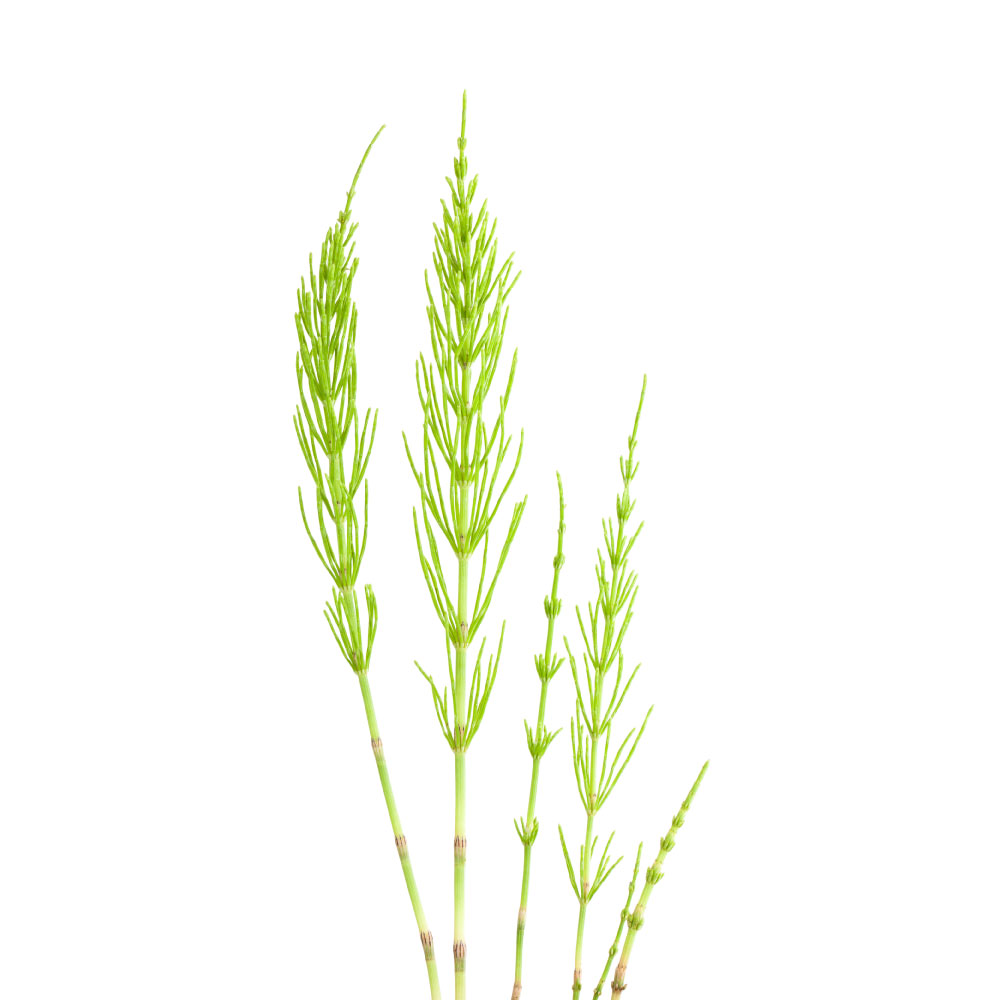What is Horsetail?
Horsetail is the last remaining member of a class of plants that used to dominate the terrain for over 100 million years. These unusual vascular plants reproduce via spores and have been incredibly successful despite the vast majority of the related species having gone extinct.
They're high in minerals, and offer support through their ability to flush the urinary tract — most people who use this herb use it to support hair and nail growth, or as a diuretic and urinary antispasmodic.
What Is Horsetail Used For?
Horsetail is mainly used for its urinary antiseptic qualities to treat urinary tract infections (cystitis, urethritis). In men, horsetail is used to treat benign prostatic hyperplasia.
It is also used for its high silica content to support nail and hair growth and is used traditionally for rheumatic pain.
Traditional Uses of Horsetail
Horsetail was used in traditional western herbal medicine for cystitis, urethritis, frequent urination, nocturnal enuresis, urinary calculi, renal colic, hematuria, enlarged prostate, prostatitis, to speed wound healing, and to stop bleeding [3, 7].
The British herbal pharmacopeia lists horsetail as a genitourinary astringent, antihaemorrhagic, and prophylactic causing a mild leucocytosis. Topically it is suggested as a vulnerary, and styptic. Indications include enuresis, prostatic disease, and cystitis with haematuria [2].
All species except Equisetum palustre have been used as a food. This is because Equisetum palustre is toxic due to the constituent palustrine (an alkaloid) [5]. In Japan, Equisetum arvense is made into a health drink known as sagina [6].
Herb Details: Horsetail
Herbal Actions:
- Diuretic
- Urinary Antiseptic
- Urinary Antispasmodic
- Astringent
- Styptic (Hemostatic)
- Vulnerary
- Antibacterial
- Antilithic
Weekly Dose
- (1:2 Liquid Extract)
15-40 mL - View Dosage Chart
Part Used
Aerial parts
Family Name
Equisetaceae
Distribution
Horsetail can be found all over the world, but is most common in North America and Europe in marsh or wetter areas.
Constituents of Interest
- Silica
- Palustrine
- Salicylic acid
- Equisetonin
Common Names
- Horsetail
- Equisetum
- Scouring rush
- Horse pipes
- Joint Grass
- Bottle Brush
- Snake Grass
- Puzzle Grass
CYP450
Unknown
Nature/Taste
Unknown
Pregnancy
Unknown
Duration of Use
- Avoid long-term use in therapeutic doses.
Botanical Information
Horsetail is the only living member of the family Equisetaceae, and the only member of its class, Equisetopsida, as well. This class used to dominate much of the Paleozoic forests for over 100 million years. The class included species that reached monstrous heights, some reportedly reaching over 30 meters tall. Since this time, however, only the lonely horsetail has survived. It is an ancient species and a bit of a time capsule for the other members of the Equisetopsida class of plants.
The class was characterized by vascular plants that reproduce via spores rather than seeds. This makes horsetail unique in a world dominated by angiosperms.
There are reportedly 5 species in the subgenus Equisetum which includes Equisetum arvense, Equisetum sylvaticum, Equisteum fluviatile, Equisetum telmateia and Equisetum palustre [5].
Habitat Ecology, & Distribution
Horsetail is a common European and North American herb, especially surrounding rivers marshes, or other damp areas.
Pharmacology & Medical Research
+ Antioxidant
Equisetum telmateia was found in at least one study to have the highest antioxidant capacity out of several other species including Equisetum arvense, Equisetum sylvaticum, Equisetum fluviatile, and Equisetum palustre [5].
+ Antibacterial
Various horsetail species have been found to be moderately to highly active against gram-positive bacterial strains [8-10].
Constituents
| Chemical class | Chemical Name | % Dried Weight | Solubility |
|---|---|---|---|
| Alkaloids | Nicotine, palustrine, palustrinine | Unknown | N/A |
| Enzymes | Thiaminase | Unknown | N/A |
| Flavonols | Isoquercetrin, Equicetrin?, Kaempferol, Quercetin, | Unknown | N/A |
| Hydrocinnamic Acids | Caffeic acid and derrivatives | 5-8% | N/A |
| Phenolic Acids | Salicylic acid | 5-8% | N/A |
| Saponins | Equisetonin, | Unknown | N/A |
| Sterols | Cholesterol, Isofucosterol, Campesterol | Unknown | N/A |
| Thiols | Dimethylsulphone | Unknown | N/A |
| Minerals | Potassium salts, magnesium salts | 1.5% | N/A |
| MISC | Aconitic acid, | Unknown | N/A |
Clinical Applications Of Horsetail:
Horsetail is reliable as a urinary antiseptic and can be used to treat lower urinary tract infections. The silica content in horsetail is very high, which is used as a nutritive for supporting nail and hair growth.
Recent Blog Posts:
References:
Wren, R. C. (1956). Potter's new cyclopaedia of botanical drugs and preparations.
British Herbal Medicine Association. (1983). British Herbal Pharmacopoeia. Bournemouth, UK: Author.
Bone, K. (2003). A clinical guide to blending liquid herbs: Herbal formulations for the individual patient. Edinburgh [u.a., MO: Churchill Livingstone.
Hoffmann, D. (2003). Medical herbalism: The science and practice of herbal medicine. Rochester, VT: Healing Arts Press.
MilovanoviÄ, V., RaduloviÄ, N., TodoroviÄ, Z., StankoviÄ, M., & StojanoviÄ, G. (2007). Antioxidant, Antimicrobial and Genotoxicity Screening of Hydro-alcoholic Extracts of Five Serbian Equisetum Species. Plant Foods For Human Nutrition, 62(3), 113-119.
Nagai T, Myoda T, Nagashima T (2005) Antioxidative activities of water extract and ethanol extract from field horsetail (tsukushi) Equisetum arvense L. Food Chem 91:389–394
Castleman M (1991) The healing herbs. Rodale Press, Emmaus, PA
Herrera RM, Perez, M, Martın-Herrera DA, Lopez-Garcıa R, Rabanal RM (1996) Antimicrobial activity of extracts from plants endemic to the Canary Islands. Phytother Res 10:364–366
Kelmanson JE, Jäger AK, Van Staden J (2000) Zulu medicinal plants with antibacterial activity. J Ethnopharmacol 69:241–246
Ali NAA, Jülich WD, Kusnick C, Lindequist U (2001) Screening of Yemeni medicinal plants for antibacterial and cytotoxic activities. J Ethnopharmacol 74:173–179











As COVID-19 continues to spread around the world, we’re getting a lot of questions on what the potential role of herbal medicine is during the outbreak. Learn how the virus works and how to limit your chances of transmission.